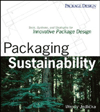2025: The Year Compostable Packaging Steps Into the Spotlight

Image courtesy of: Oleksandr Slobodianiuk / iStock via Getty Images Plus; phototechno / DigitalVision Vectors via Getty Images Plus
Without significant intervention, global plastic waste is on track to nearly triple by 2060—a sobering reality with dire consequences. Beaches are already buried under plastic debris, marine life is choking on garbage, landfills are overflowing and leaching toxins into the air and groundwater, and microplastics have infiltrated soil and food supplies. As the crisis intensifies, these environmental hazards will multiply, posing an ever-greater direct threat to human health.
In this urgent context, the packaging industry faces a dual challenge: to drastically reduce plastic waste while preserving the functionality and efficiency businesses and consumers rely on. As we enter 2025, compostable packaging has emerged as a vital tool in the industry’s sustainability arsenal. With rapid advancements in innovation and growing consumer demand, this year is set to be a turning point.
Here are four key predictions for compostable packaging in the year ahead.
1. High-barrier materials will bring compostables to new industries and markets
In 2025, high-barrier compostable materials will help redefine the sustainable packaging landscape. These cutting-edge materials provide protection against moisture and oxygen and have been proven to ensure product freshness and even extend shelf life. As a result, they are a viable replacement for the traditional plastic laminates used in perishable goods. This breakthrough opens the door for compostable packaging to enter new and growing markets, including crisps, snacks, condiments, and ready-to-eat meals, where performance has long been dominated by non-recyclable plastics.
2. Small-format compostables will start tackling recycling challenges for hard-to-process items
In 2025, small-format compostable packaging will increasingly emerge as a game-changer for mixed material items that typically get sorted out of traditional recycling systems or not sorted at all. Products like single-use sachets, wrappers, coffee pod lids, fruit and vegetable stickers, and tea bag seals often end up in landfills due to their size and material differences from other parts of the same packaging, which make them incompatible with standard recycling methods. As regulatory scrutiny on single-use plastics intensifies and consumer demand for eco-friendly options grows, small-format compostables will begin to see broader adoption as a practical solution for these hard-to-recycle items.
3. Demand for end-to-end compostable systems will gain momentum
In 2025, brands will recognize that a piecemeal approach to sustainability is no longer sufficient. Stricter environmental regulations will compel them to take more decisive action to curb plastic waste, while consumers increasingly seek packaging that aligns with their environmental values at every level. This dual pressure is likely to push end-to-end compostable systems into greater focus. By ensuring that every component—from zippers to lids, stickers, and seals—is compostable, brands can better address these heightened expectations and take steps to move away from reliance on traditional plastic.
4. Global collaboration will begin advancing adoption, innovation and infrastructure
In 2025, global collaboration will play an instrumental role in advancing compostable packaging. Governments, businesses, and advocacy groups are beginning to join forces to tackle plastic waste. These partnerships will help drive the adoption of compostable solutions, foster innovation, and support infrastructure development by gradually expanding regional facilities and working toward standardized practices. By aligning efforts across borders and sectors, collaboration will make compostable packaging more practical and accessible, paving the way for a sustainable future.
Looking ahead
As 2025 unfolds, the true challenge will lie in scaling these solutions and ensuring they are accessible and affordable across industries and regions. Success will require not just technological progress, but also continued collaboration, regulatory support, and consumer engagement. If the packaging industry can rise to meet these challenges, compostable packaging has the potential to redefine sustainability standards and lead the way to a future where packaging leaves no lasting mark on the planet.
Looking for a reprint of this article?
From high-res PDFs to custom plaques, order your copy today!










